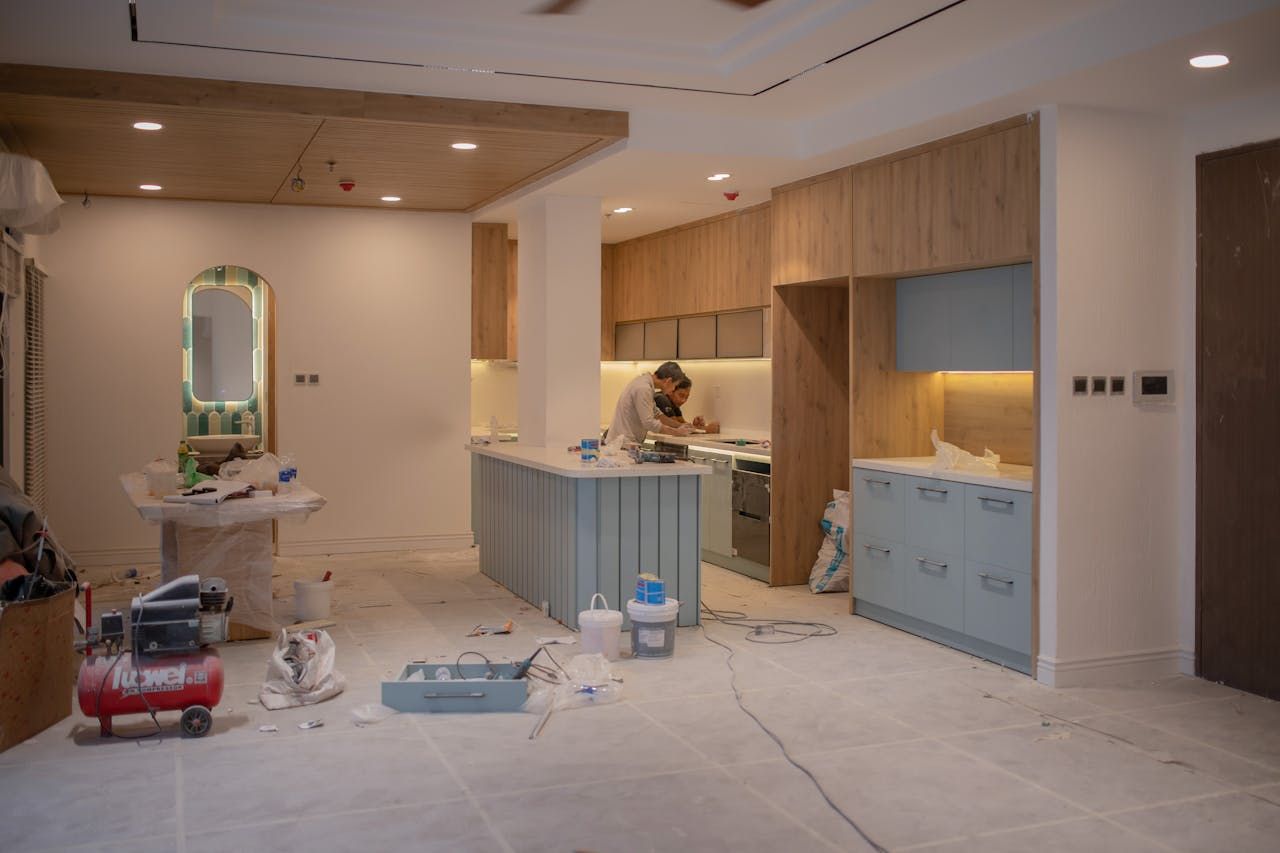Abbotsford Home Renovations
Kitchen Renovation Mistakes Homeowners ALWAYS Regret
Kitchen renovation Abbotsford can increase a home’s value and functionality, but it’s easy to make decisions that lead to future regrets without a clear plan and technical insights.
A kitchen remodel can cost anywhere from five to fifteen percent of your home's value, according to the HomeStars— network of home renovation experts. In Canada, a kitchen remodel can range in price from $13,000 for a simple update to over $40,000 for a complete overhaul.
Since this is a sizable financial commitment, you should only work with professionals on your kitchen renovation Abbotsford project. Here, we’ll explore some renovation mistakes homeowners often make and offer expert advice to avoid these pitfalls.
Choosing Style Over Durability in Countertops and Cabinets
Countertops and cabinets define a kitchen’s aesthetic, but prioritizing style over durability is a frequent regret. High-quality materials improve longevity and contribute to the resale value. Homeowners should calculate long-term costs, factoring in potential repairs and replacements.
Countertop Materials: Pros and Cons
- Granite: Known for its resistance to heat and scratches. Requires regular sealing to prevent staining.
- Quartz: Durable and non-porous. Can be susceptible to heat damage. Ideal for busy kitchens as it’s maintenance-free.
- Marble: Luxurious but highly porous and prone to scratches and stains. Suited for low-traffic kitchens.
Cabinetry Materials and Finishes
- Solid Wood: Offers durability but may warp in humid conditions. Proper sealing and moisture control are necessary to extend its life.
- Particleboard or MDF: These are cost-effective but less durable than solid wood. If exposed to moisture, particleboard cabinets can swell and break down over time.
- Laminates and Thermofoil: Aesthetically versatile, but can delaminate over time. Not ideal for high-traffic kitchens or areas exposed to heat.
Ignoring the Workflow Triangle
The workflow triangle—the spatial relationship between the stove, sink, and refrigerator—is essential for efficient movement. Ignoring this design principle leads to inconvenience and frustration.
Understanding the Triangle’s Purpose
| Benefit | Details |
|---|---|
| Optimal Distance | Each point of the triangle should ideally be 4-9 feet apart. If distances are too short, the area feels cramped; too long, and it becomes inefficient. |
| Traffic Flow | Avoid placing the triangle in a high-traffic area where people passing through disrupt cooking tasks. Position the triangle in a part of the room with minimal foot traffic. |
| Appliance Proximity | Ample counter space adjacent to each appliance is a must to facilitate prep work, especially near the stove and refrigerator. |
Common Errors with the Triangle
- Placing the Refrigerator Far from the Sink. Can complicate food prep and cleanup.
- Insufficient Counter Space Adjacent to the Stove. Essential for a safe cooking experience, lack of counter space leads to juggling hot pots and ingredients.
Planning the workflow triangle is especially important in smaller kitchens where every inch counts. Homeowners should work with their general contractor to carefully map out the triangle’s placement, avoiding design sacrifices for aesthetics or trends.
Installing Too Few Electrical Outlets
A lack of outlets is a common yet critical oversight in today's tech-driven kitchens. A thoughtfully planned electrical layout prevents future frustrations and minimizes clutter caused by extension cords.
Estimating Outlet Needs Based on Use
Plan multiple outlets along the countertop to power frequently used appliances like coffee makers, toasters, and mixers. With mobile devices and smart gadgets, allocating outlets for USB or wireless chargers can be a convenience booster. Outlets near the stove allow convenient plug-ins for blenders or food processors, minimizing trips across the room.
Adhering to Electrical Codes
- GFCI Protection: Kitchens must have Ground-Fault Circuit Interrupter (GFCI) outlets to prevent electric shock in wet areas. GFCIs should be installed within 6 feet of sinks and any water source.
- 20-Amp Circuits: High-wattage appliances like microwaves require dedicated 20-amp circuits to avoid overloading.
- Spacing Guidelines: The 2021 Canadian Electrical Code amendments require outlets every 1.8m along countertops to prevent cords from stretching.
Adding outlets during the renovation phase is simpler and more affordable than adding them afterward. Consulting home renovation contractors to ensure code compliance and proper outlet distribution is essential for a safe, functional area.
Overlooking Adequate Lighting
Many homeowners underestimate the importance of a layered lighting plan, resulting in a dim or overly harsh space.
- Ambient Lighting: General overhead lighting will illuminate the room evenly. LED recessed lights are an energy-efficient choice for ambient lighting.
- Task Lighting. Essential for work areas like countertops, sinks, and stoves. Undercabinet lighting offers direct illumination.
- Accent Lighting: Adds depth and highlights architectural features or display items, such as glass cabinets. Pendant lights over islands serve decorative and functional purposes.
Colour Temperature and Brightness Levels
A well-planned lighting scheme improves kitchen safety and usability while enhancing aesthetics. Many homeowners regret not investing in lighting, as it’s challenging to retrofit fixtures without significant additional expense.
- Kelvin Scale: Choose lighting within the 3000K–4000K range for a warm yet functional glow.
- CRI (Colour Rendering Index): A CRI of 90+ appear natural and vivid, which is especially beneficial for food preparation.
Skimping on Ventilation Systems
Adequate ventilation keeps air quality high and prevents lingering odours and grease buildup. Many homeowners overlook this, leading to issues like cooking smells permeating the home and poor air quality. Proper ventilation is a long-term investment that protects cabinets, walls, and other surfaces from grime and extends the life of the kitchen itself
Types of Range Hoods and Venting Options
| Type | Details |
|---|---|
| Ducted Range Hoods | Vent air outside, offering the best odour and moisture control performance. However, they require access to an exterior wall. |
| Ductless Range Hoods | Recirculate air through a filter. While easier to install, they are less effective than ducted systems and need frequent filter replacements. |
| CFM Rating | A range hood with a higher CFM (cubic feet per minute) rating is ideal for larger kitchens or frequent high-heat cooking. Aim for a range hood with a CFM rating that matches the kitchen’s needs. |
Strategic Placement and Airflow Considerations
- Distance from Cooking Surface: Hoods should be 24-30 inches above the cooktop for adequate airflow. Positioning them too high reduces their ability to capture steam and grease.
- Noise Levels: Consider the range hood's sone rating (noise level), as louder models can disrupt the ambiance.
Ignoring Storage Needs
One of the biggest regrets homeowners report after a renovation is a lack of storage. With thoughtful planning, every inch of space can be optimized. Anticipate future storage needs, factoring in potential lifestyle changes. For example, a growing family might need more pantry space—plan storage for immediate needs and long-term usability.
Configurations of Kitchen Cabinets for Maximum Space
- Pull-Out Drawers: Allow easy access to pots, pans, and pantry items without reaching deep cabinets.
- Corner Solutions: Lazy Susans or corner drawers maximize hard-to-reach spaces.
- Vertical Dividers: These are great for upright storage of cutting boards, baking sheets, and other flat items, optimizing cabinet space.
- Slide-Out Pantry Systems: Ideal for narrow spaces, these allow you to access items easily.
Drawer Inserts and Dividers: Help organize utensils, making cooking more efficient.

Plan Carefully to Avoid Renovation Project Regrets
Abbotsford kitchen renovations require detailed planning and expert input to avoid common mistakes. By focusing on functionality, durability, and technical essentials, homeowners can have a successful kitchen renovation process they won’t regret.
Working with Abbotsford Home Renovations to map out every detail allows for an investment that improves home value and day-to-day usability. Our kitchen renovation services in Abbotsford, BC, improve your existing space by considering what your home needs and what you prefer. We can also handle bathroom renovation, house expansion, modern home updates, and more.
Frequently Asked Questions
How can I maximize space in a small area without making it feel cramped?
Effective use of vertical space is essential in smaller areas.
- Choose custom cabinets that reach the ceiling and open shelving to avoid feeling confined.
- Integrate multi-functional items, like an island with built-in storage
- Keep a cohesive colour scheme to make the space feel more open.
- Adding mirrors or glass-front custom cabinetry can also create an illusion of depth.
How do I choose the best flooring for kitchens?
Kitchens require durable, moisture-resistant flooring that withstand heavy foot traffic. Options like tile, vinyl, engineered wood, and laminate flooring are popular due to their resilience. Avoid materials that are easily damaged by water or are high-maintenance. Non-slip finishes and easy-to-clean surfaces create a safer, more practical floor.
Should I follow trends or stick with a timeless design?
While trends can add a fresh look, it is wise to balance them with timeless elements— especially for larger investments like new cabinets and countertops. You can incorporate trends in more easily changeable features, like paint colours, light fixtures, or accessories. This way, the core elements remain functional and appealing regardless of trends.
